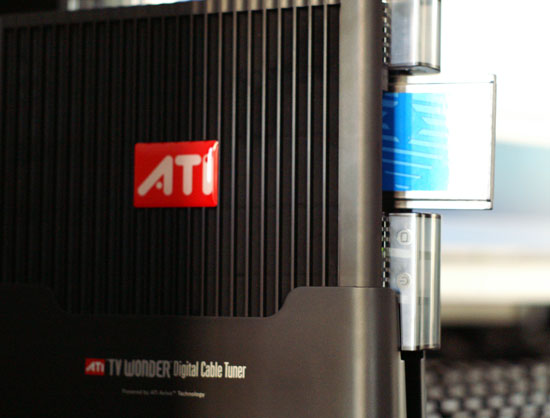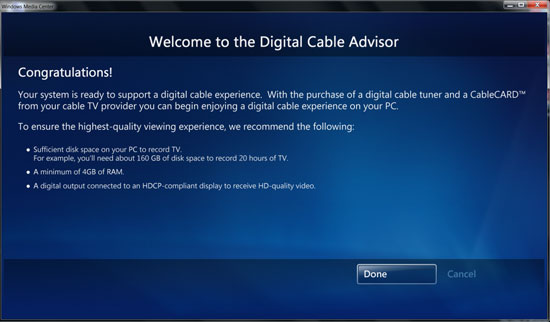The Cable Chronicles: Win7 Digital Cable Advisor Released
by Ryan Smith on November 9, 2009 12:00 AM EST- Posted in
- Ryan's Ramblings
As we mentioned in our previous edition of The Cable Chronicles, Microsoft and CableLabs have come to an agreement to allow the installation and use of CableCARDs on unapproved and non-OEM systems, allowing for the wider proliferation of CableCARD equipped HTPCs beyond the handful of OEM systems that CableLabs had previously approved. With Windows 7 implementing a complete DRM scheme for TV tuners – the Protected Broadcast Driver Architecture – computers running Win7 would be the first to be able to take advantage of these relaxed restrictions.
The limitation at the time was that computers did not come CableCARD-capable out of the box. A Digital Cable Advisor tool was to be released by Microsoft, which would check a computer to make sure it meets all of MS’s and CableLab’s requirements, before going ahead and enabling CableCARD access. That tool was supposed to be released in time for Win7’s launch, but it ended up being AWOL at the time. As Microsoft was not going to publish the complete system requirements for using a CableCARD, this tool was the only way to find out the system requirements.
The tool was finally released this weekend, allowing us to get an idea of what the system requirements are.
The tool comes as a Windows Media Center Extra, and needs to be downloaded, installed, and used from within Windows Media Center. If you don’t regularly run MCE, then it probably won’t show up in the Extras Gallery, as MCE picks up on it when it regularly checks in for updates. To force MCE to check in, go to Settings -> General -> Automatic Download Options -> Download Now.

Once installed. It shows up in your Extras Gallery.

When activated, the tool will analyze the system to determine if it meets MS/CableLab’s requirements, reporting back whether the computer passes or fails the requirements, and if it fails, offers a short explanation why.
Digging through the tool’s support files, for most of the system requirements the tool appears to just be looking at the Windows Experience Index of the computer. The chart below lists the scores we’ve found, and the text attached to them if the computer fails
| WEI Score | Attached Text | |
| Memory | 4.3 | While 2GB of RAM is sufficient for most broadcast content 4GB of RAM is recommended for the best viewing experience |
| CPU | 2.2 | A Dual Core CPU or better is recommended for the best viewing experience |
| Graphics | 3.3 | Your graphics card or driver doesn't meet the minimum requirements |
| COPP/HDCP | x | Your graphics card or driver doesn't support content protection |
| DXVA | x | We recommend that you update your video card to one that supports hardware acceleration |
In spite of the attached text, the tool doesn’t appear to actually be looking for specific pieces of hardware. We ran this test on a single-core computer with 1.5GB of RAM, and it passed anyhow, as it met the WEI scores required. So our best guess is that only WEI scores matter here.
The second test tests the Content Protection (Read: DRM) capabilities of the hardware. It appears to be looking for the various MCE DRM components (PBDA and PlayReady), HDCP support, and DXVA acceleration of MPEG-2. We suspect the DXVA check is just a warning rather than a hard error, but we don’t have any appropriate hardware to test this.
From our testing, we believe the tool will fail if HDCP support is not present in the video card, regardless of if a digital connection is being used. The big question we have, and one we haven’t been able to find an answer to, is whether HDCP is required for digital connections (e.g. an older TV using HDMI), as we don’t have a monitor on-hand that doesn’t support HDCP.
The analog situation looks better. On a PC hooked up to a TV via Component, it passed the check and was allowed to enable CableCARD support.
However once a PC passes the test, the final screen leaves us scratching our heads as to whether the tool actually knows what it’s doing.
The screen is a list of recommended hardware:
- Sufficient disk space on your PC to record TV. For example, you’ll need about 160GB to record 20 hours of TV
- A minimum of 4GB of RAM
- A digital output connected to an HDCP-compliant display to receive HD-quality video.
We’re not sure where the disagreement lies. It could very well be that the tool isn’t checking for an HDCP-attached monitor and is just blindly approving everything so long as there’s HDCP support, or that it’s downscaling content going out an analog output (ala the Image Constraint Token on Blu-Ray), or it could be that this is an empty recommendation. This tool was supposed to clear up confusion about what’s required for CableCARD use, and it hasn’t really achieved that.
Finally, in the strangest occurrence, one of our systems was already authorized according to the tool. The Core i7 rig we use for benchmarking shows up as authorized, even on a fresh install of Windows 7. This is expected behavior for OEM systems (or rather, motherboards) that were previously approved by CableLabs, but we have no idea why this would be showing up on an Asus Rampage II Extreme.

Finally, along with the release of the advisor tool, the updated firmware for the ATI TV Wonder Digital Cable Tuner needed to go with these looser restrictions has finally been released. As this was originally intended as an OEM-only product, the only place we’ve seen it thus far is at Dell’s website, where they want $210 for a tuner. Since it’s a single-stream tuner, you’ll want 2 (or more) to watch & record multiple channels. Other vendors will have CableCARD tuners out, including multi-stream tuners, but not until next year. For the time being, CableCARD on Win7 comes with a high early adopter tax.













30 Comments
View All Comments
erple2 - Monday, November 9, 2009 - link
That seems to be a bit excessive for the ability to watch CableCARD protected content. A fully paid for TiVo HD costs 700 dollars. That also buys you the TiVo service, however. I suppose a valid argument can be made that the TiVo can't do as much as a full-blown PC (built in Blu-Ray player, streaming "other" streams from the intertubes, surf the intertubes, etc), but the cost of entry is now quite a bit less of a difference for the PC HT.I think that I might be willing to pay 250 for a multichannel capable tuner card, not 500 for "equivalent" ability (plus the potential headaches of installing 2 such tuners in my PC). As a minor cost, my cable provider (Verizon FIOS) charges per card, not per stream, so the multistream card costs me "half" per month as 2 single stream cards.
Colin1497 - Monday, November 9, 2009 - link
Exactly. I stream you-name-it from my PC to my TiVo already. I guess this product is basically for those who just have to have something to tinker with.numberoneoppa - Monday, November 9, 2009 - link
http://www.cetoncorp.com/ProductsWMC.php">http://www.cetoncorp.com/ProductsWMC.phpTV Tuner card on steroids.
mckirkus - Monday, November 9, 2009 - link
Interesting tidbit from the FAQ:"A: The Ceton Multi-Channel Cable TV Card takes advantage of standard Media Center Extenders including the Xbox 360 to distribute live and recorded programs to multiple TV sets in the home. No special installation or configuration of the extenders is required by the Ceton card.
Depending on which versions of Windows 7 and the Ceton card you have, you will be able to distribute either 2, 4 or 6 live TV channels around the home with a single CableCARD installed and using a single RF connection.
So in a typical 4-tuner home installation, you could have 4 different TV sets in 4 different rooms, each watching or recording (or some combination of watching and recording) a different show in HD at the same time."
I plan to buy one and use My XBox 360 as a cable box / DVR in my bedroom. That'll save two cable boxes which works out to $22 a month or ~$250 a year.
My only concern is bandwidth to my bedroom, I can't currently stream hi-def MKV files via wifi to my XBox 360 extender without buffering. Also, Xbox 360 chokes if you have a lot of content.
numberoneoppa - Monday, November 9, 2009 - link
I would highly recommend just wiring your house for ethernet using a roll of cat6 or 5e. It comes out to be around 125 bucks for everything needed during the project (1000 ft cable, connectors, crimper, wall gangs, covers) and it's totally worth it in the long run!glugglug - Tuesday, November 10, 2009 - link
Don't know how you are getting that it is $125. I wired my place myself a few weeks ago. 500 ft cable was bundled with a bag full of connectors, a crimping tool, and a cable tester for $35. If you search online there are some good deals on this stuff.But yeah, wireless is way too flaky for media streaming. At a minimum if you are going to go wireless you need to go wireless N instead of wireless g to have enough bandwidth, with dual band routers & access points set on 5GHz instead of the default 2.4GHz band so they don't get interference from microwaves, bluetooth devices, legacy wireless g networks & devices, etc. HD streaming requires 10MBps. Yes, I am aware wireless G stuff is marketed as 56MBps, but that is only theoretical when you have no interference, your signal doesn't need to go through any walls, etc, and is very far from reality.
dagamer34 - Wednesday, November 11, 2009 - link
It's not just the speed you have to think about when going wireless, but the potential of data packet loss. When streaming HD video, lost data packets are going to cause stuttering like you'd never believe.Though I don't how you got the price down to $35. You're at least going to need to get a gigabit switch to route all your cables, and that'll swallow your $35 whole.
mckirkus - Monday, November 9, 2009 - link
Forgot to mention... Anybody want to bet that the next generation games consoles are going to have cable card slots built in?gcannon - Monday, November 9, 2009 - link
Cannon PC (www.cannonpc.com) have the internal and external versions of the ATI Digital CableCARD tuners available ($249)Spivonious - Monday, November 9, 2009 - link
I'm glad to see the restrictions lifted. Now we just need something worth watching on those encrypted channels.